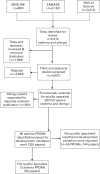Patient-reported outcome measures for asthma: a systematic review
- PMID: 24964767
- PMCID: PMC4373322
- DOI: 10.1038/npjpcrm.2014.20
Patient-reported outcome measures for asthma: a systematic review
Abstract
Background: Patient-reported outcome measures (PROMs) are measures of the outcome of treatment(s) reported directly by the patient or carer. There is increasing international policy interest in using these to assess the impact of clinical care.
Aims: To identify suitably validated PROMs for asthma and examine their potential for use in clinical settings.
Methods: We systematically searched MEDLINE, EMBASE and Web of Science databases from 1990 onwards to identify PROMs for asthma. These were critically appraised, then narratively synthesised. We also identified the generic PROMs commonly used alongside asthma-specific PROMs.
Results: We identified 68 PROMs for asthma, 13 of which were selected through screening as being adequately developed to warrant full-quality appraisal: 8 for adults, 4 for children and 1 for a child's caregiver. The PROMs found to be sufficiently well validated to offer promise for use in clinical settings were the Asthma Quality of Life Questionnaire (AQLQ) and mini-AQLQ for adults, and Pediatric Asthma Quality of Life Questionnaire for children. Rhinasthma was considered promising in simultaneously assessing the impact of asthma and rhinitis in those with coexistent disease. We identified 28 generic PROMs commonly used in conjunction with asthma-specific instruments.
Conclusions: We identified asthma PROMs that offer the greatest potential for use in clinical settings. Further work is needed to assess whether these are fit-for-purpose for use in clinical practice with individual patients. In particular, there is a need to ensure these are validated for use in clinical settings, acceptable to patients, caregivers and clinicians, and yield meaningful outcomes.
Figures
References
-
- Kirshner B, Guyatt G. A methodological framework for assessing health indices. J Chronic Dis. 1985;38:27–36. - PubMed
-
- Smith S, Cano S, Lamping D, Staniszewska S, Browne J, Lewsey J. Patient-Reported Outcome Measures (PROMs) for Routine Use in Treatment Centres: Recommendations Based on a Review of the Scientific Evidence. Health Services Research Unit, London School of Hygiene & Tropical Medicine: London, UK; 2005.
-
- Department of Health . Guidance on the Routine Collection of Patient Reported Outcome Measures (PROMS) DH: London, UK; 2008.
-
- Medical Research Council . Patient Reported Outcome Measures (PROMS): Identifying UK Research Priorities. MRC: London, UK; 2009.
-
- Peters M, Crocker H, Dummett S, Jenkinson C, Doll H, Gibbons E. Pilot study of patient reported outcome measures (PROMs) in primary care. 2013.
Publication types
MeSH terms
LinkOut - more resources
Full Text Sources
Other Literature Sources
Medical


